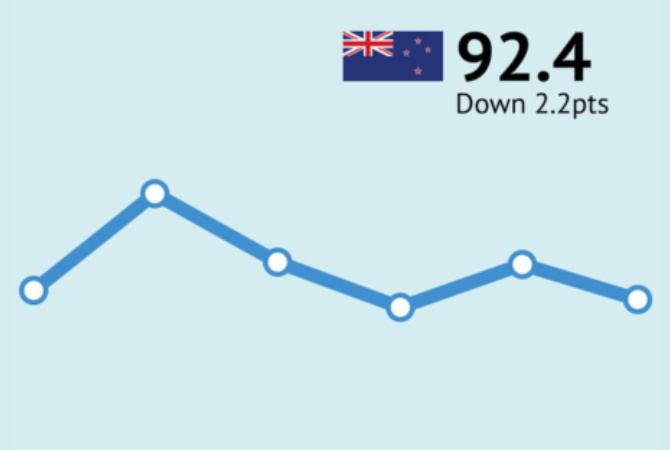ANZ-Roy Morgan New Zealand Consumer Confidence fell slightly from 94.6 to 92.4 in October, giving up last month’s gains

Key points
- The proportion of households thinking it’s a good time to buy a major household item (the best retail indicator) fell from -11 to -14. This indicator hasn’t been positive in more than four years.
- Inflation expectations lifted from 4.8% to 5.1%.
Turning to the detail (see charts on page 4 of the linked PDF):
- The future conditions index made up of forward-looking questions eased from 99.0 to 97.0, but is much higher than the current conditions index (85.5), which eased a similar amount.
- Perceptions of current personal financial situations (better or worse off than last year) eased 2 points to -15% with just over a quarter of respondents, 27% (down 5% points) now saying they are 'better off' financially than this time last year compared to a plurality of 42% (down 2% points) who say they are 'worse off'. The net result of -15% is not far off the average of the year thus far.
- A net 9% of respondents expect to be better off this time next year, down 5 points with 39% (down 4% points) of respondents saying they expect to be 'better off' financially this time next year compared to 30% (up 1% point) that expect to be 'worse off'.
- A net 14% think it’s a bad time to buy a major household item with just under a third, 31% (down 4% points) of respondents saying now is a 'good time to buy' major household items compared to a virtually unchanged 45% that say it's a 'bad time to buy' , suggesting caution continues, though our card spending data shows a pickup.
- Perceptions regarding the economic outlook over the next 12 months lifted 1 point to -22%. The 5-year-ahead measure fell 2 points, but is much more positive at +4%.
- House price inflation expectations lifted from 2.5% to 3.1%.
- Two-year-ahead CPI inflation expectations rose from 4.8% to 5.1%, close to actual food price inflation of 4.6%, but much higher than CPI inflation of 3%. In recent years there has been a strong negative correlation between inflation expectations and confidence.
ANZ New Zealand Roy Morgan Consumer Confidence hasn’t budged even as many other economic indicators have improved from their mid-year lows. The reluctance to spend in recent years has hit the retail sector hard. Figure 2 in the linked PDF shows the net percentage of consumers saying it’s a good time to buy a major item versus the net percentage of retail firms in the ANZ Business Outlook survey who say that their activity is higher than a year ago. Of late, retail businesses have reported a more mixed performance, but the current trend is upward. Meanwhile, consumers’ reported willingness to buy has been more stable.
Check out the latest data of ANZ-Roy Morgan New Zealand Consumer Confidence here: ANZ-Roy Morgan New Zealand Consumer Confidence
For comments or more information please contact:
Roy Morgan - Enquiries
Office: +61 (03) 9224 5309
askroymorgan@roymorgan.com
Margin of Error
The margin of error to be allowed for in any estimate depends mainly on the number of interviews on which it is based. Margin of error gives indications of the likely range within which estimates would be 95% likely to fall, expressed as the number of percentage points above or below the actual estimate. Allowance for design effects (such as stratification and weighting) should be made as appropriate.
| Sample Size | Percentage Estimate |
| 40% – 60% | 25% or 75% | 10% or 90% | 5% or 95% | |
| 1,000 | ±3.0 | ±2.7 | ±1.9 | ±1.3 |
| 5,000 | ±1.4 | ±1.2 | ±0.8 | ±0.6 |
| 7,500 | ±1.1 | ±1.0 | ±0.7 | ±0.5 |
| 10,000 | ±1.0 | ±0.9 | ±0.6 | ±0.4 |
| 20,000 | ±0.7 | ±0.6 | ±0.4 | ±0.3 |
| 50,000 | ±0.4 | ±0.4 | ±0.3 | ±0.2 |



